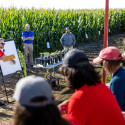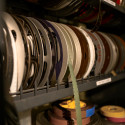Physical Plant programs address campus’ renovation needs
On a campus where foundations, walls, edifices and interiors have logged more than 100 years of history, many buildings are losing a slow tug-of-war against time. But in the seemingly insurmountable battle to maintain those buildings, systematic progress is being made.
 Physical Plant carpenters Bruce Steinhofer (left) and Mark Murphy remove old shelving from the library in the Teacher Education Building as part of a CURB corrective maintenance project. |
|
Refinishing school A sample of what CURB has done during one recent project in Russell Labs:
|
Thanks to a pair of facilities reconditioning programs instituted by the Physical Plant, campus’ historic buildings are, one by one, getting a thorough refreshing.
The north wing of the Social Science Building was the first building in 1991 to undergo renovation under the Concentrated Upgrade and Repair of Buildings, or CURB, program. Since then, a dozen CURB projects have been or soon will be completed, covering more than 1.2 million square feet of space. CURB’s only project for 1998-99, will begin at Birge Hall in July.
CURB’s companion program is the Comprehensive Assessment and Refurbishment of Equipment, or CARE, program. Since 1994, CARE has overhauled heating, ventilation and air conditioning systems in 17 buildings.
The programs are the main components of Physical Plant’s corrective maintenance system. (Other rehabilitation work falls under the Physical Plant’s Project Administration Center.) “These programs work,” says Physical Plant director John Harrod. “Our efforts are cost-effective; completed projects function properly; and the building occupants are pleased with the results.” “Once we’ve reconditioned a building, it looks brand new,” says Faramarz Vakili, Physical Plant’s associate director. “We don’t remodel it. We fix up what’s there and follow up with a comprehensive preventative maintenance program to keep it in the desired condition.” In Russell Labs, for example, CURB has applied 300 gallons of paint, installed new ceilings, removed asbestos tiles and installed 300 thermostats since 1996 (see box, page 6).
“Our employees take great pride in their work and are part of a long-term solution, not just a quick fix,” Harrod says. “With additional resources, a great deal more can and should be accomplished.”
Funding for the programs has increased in every year since their initiation, starting with a modest budget of $314,000 in 1991-92. To date, more than $3.7 million has been invested in CURB, an average cost of about $4 per square foot refurbished. CARE has added another $800,000 to the renovation price tag. For 1996-97, CURB’s budget was nearly $1.4 million.
Much of the money has come from other Physical Plant sources. “We were consumed with work order requests, so we decided to take a certain percentage of our resources in each trade and dedicate them to CURB and CARE,” says Vakili. Some additional financial help has come from the state and the university’s administration.
Despite its success, CURB and CARE may seem to be making slow progress against the mounting need for renovation on campus. Vakili notes, however, that because of the coordination required – scheduling with various trade workers and minimizing disruption – CURB and CARE are only able to take on one or two projects a year.
“The buildings we select are definite drains on our reactive maintenance resources,” says Vakili, noting that Physical Plant’s steamfitter shop received some 270 service calls from the Waisman Center during the year prior to a 1994 CURB project.
“We consider code issues, indoor air quality problems – all of those things make a difference in how we go about selecting the buildings. We really can’t go wrong. They all need it,” says Vakili.
For inhabitants of some of those needy buildings, Vakili urges patience. He knows the enormity of work that lies ahead.
“Even though we may have more than a quarter of a billion dollars’ worth of deferred maintenance and it may seem like we’re feeding an elephant with a teaspoon, we have a can-do attitude and a game plan,” he says. “If we aren’t responding right away, it’s because if we did, these reconditioning programs wouldn’t have a chance to exist.”




